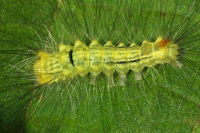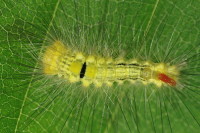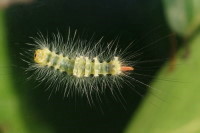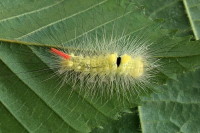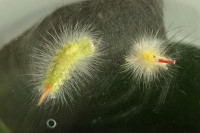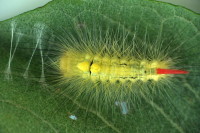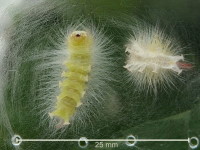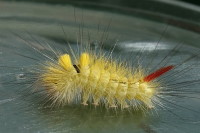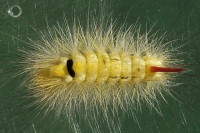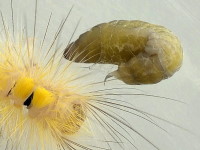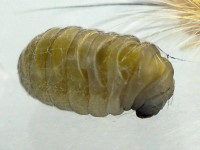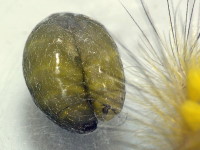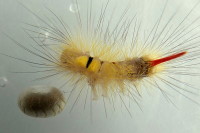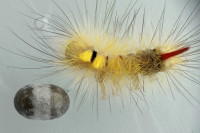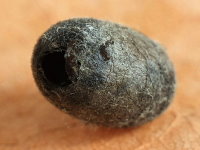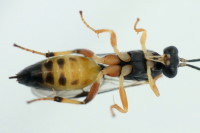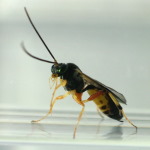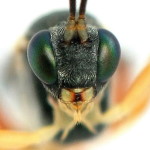From Caterpillar to Parasitic Wasp
The Development of an Endoparasitoid and its Host in Pictures
Actually, I´ve been looking forward after finding a caterpillar of Calliteara pudibunda to be able to welcome a moth next year, but it turned out differently, and now there is a parasitic wasp more. So I took that as an occasion for an internet search. An introduction to the world of parasitoids, and detailed information on parasitoid groups of arthropods and their way of life are in [1].
Calliteara pudibunda - Pale Tussock
The Pale Tussock is a moth of the subfamily Lymantriinae (formerly Lymantriidae). The Lymantriinae now belong to the family Erebidae within the superfamily Noctuoidea.[2] The medium-sized moths with a wingspan of 37-67 mm fly in one generation between late April and July. Caterpillars can take place from June to October. These feed on various trees and shrubs, among others, beech, birch, willow, hazel, rowan and oak. The caterpillars pupate in a cocoon, the pupae overwinter and in spring, from the end of April, slips a new generation moths. There are pictures of the Pale Tussock and additional information in [3-5].
The Caterpillar
On July 11, I have found on a beech leaf the young caterpillar of Calliteara pudibunda shown in Figures 1 and 2. This has skinned on 18 July. Figures 3 to 5 show the caterpillar after the 1st molt under my care. Then the caterpillar sat motionless most of the time on the cover of the breeding vessel. I offered different leaves, but it was not to realize that the caterpillar had eaten something.
Since it has skinned again, my worry that its favorite leaves were not in my selection, was first unfounded. Figures 6 and 7 show the caterpillar after the 2nd and Figures 8 and 9 the 3rd molting. During this period it has eaten something more. In Figure 8, the caterpillar can be seen together with the stripped skin at its favorite place. Clearly visible are the scratches caused by its hairs. Figures 10 to 13 show the caterpillar in its final skin. The caterpillar lived on September 15 and still has moved (Figure 11). Then it sat motionless on the underside of the cover (Figure 12 and 13). In contrast to most other adult caterpillars of Calliteara pudibunda [3,5], it has only 2 "brushs". In [4] about 50 mm is provided as the size of adult female caterpillars of Calliteara pudibunda. For the male caterpillars, which should be smaller, there is unfortunately no size specification. The caterpillar shown here has reached a length of about 2 cm (Figure 10) and has become only slightly thicker in the last 2 weeks.
On September 20, it became apparent why the caterpillar has remained so small and that there would be no moth.
The Endoparasitoid
15:30 clock, slipped a thick larva out of the caterpillar skin that looked a little brighter than on the Figures. Figure 14 shows the larva together with the abandoned skin of Calliteara pudibunda. The diligent larva immediately started up spinning a cocoon around itself (Figures 15 to 21). After less than 2 hours was a little "bun" next to the caterpillar skin (Figure 22).
From this originated overnight, the 6.5 mm large cocoon shown in Figures 23 and 24. Approximately two weeks later, on October 6, a wasp is hatched from the cocoon. Figure 25 shows the empty cocoon.
Unfortunately, the about 9 mm long, very nimble wasp could not sit still and ran most of the time on the transparent cover of the box in which it was housed around (Pictures 26 to 28). When I had removed the cover for more photos (Pictures 29 and 30), the wasp took the opportunity to escape.
Since in Figure 30 the venation of the wings can be clearly seen the wasp could be assigned to the Campopleginae, a subfamily of Ichneumonidae. Figure 31 also shows a front view of the wasp head.
Ichneumonids - Subfamily Campopleginae
The Ichneumonids (Ichneumonidae) are the most species-rich family of Hymenoptera with more than 30 subfamilies.[1] For the subfamily Campopleginae are currently 457 species detected in Germany.[2]
Wasps of the subfamily Campopleginae are usually koinobiont endoparasitoid of holometabolous insect larvae.
Holometabola are insects going in their development through complete conversion (metamorphosis) from larva via pupa to adult insect (imago).[6] Koinobiont endoparasitoids allow the host initially to continue its development. The host can eat, grow and molt several times. The parasitoid eats parts of the host body, but spares initially vital organs. Shortly before pupation or hatching of the parasitoid the host is killed in the rule. This is usually done, as in the example of Calliteara pudibunda shown here when the host adjusts its growth and, for example, will moult from larva to pupa.[7] Hosts of the Campopleginae are in addition to butterflies and moths (Lepidoptera) sawflies (Symphyta), beetles (Coleoptera) and snakeflies (Raphidiidae).[1]
Many thanks to Rapha1 for confirmation of the subfamily Campopleginae in the HymIS forum. Many thanks also to Malcolm Storey for identifying the genus Bathyplectes and subgenus Bathyplectes of the wasp shown here and the link to the identification key for the genera of the Campopleginae.[8]
References and further reading:[1] http://www.faunistik.net/PONLINE/index.html, http://www.faunistik.net/PONLINE/_EINFUEHRUNG/index.html
[2] de Jong, Y.S.D.M. (ed.) (2013) Fauna Europaea version 2.6.2 Web Service available online at http://www.faunaeur.org
[3] http://www.lepiforum.de/lepiwiki.pl?Calliteara_Pudibunda
[4] http://de.wikipedia.org/wiki/Buchen-Streckfu%C3%9F
[5] http://www.schmetterling-raupe.de/art/pudibunda.htm
[6] http://de.wikipedia.org/wiki/Holometabole_Insekten
[7] http://de.wikipedia.org/wiki/Parasitoid
[8] Campopleginae Genera

